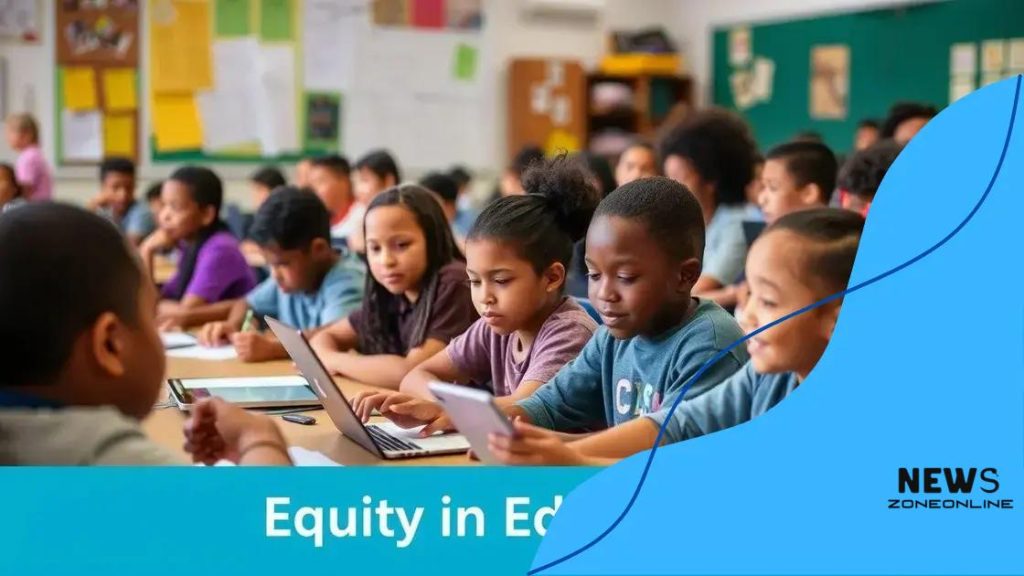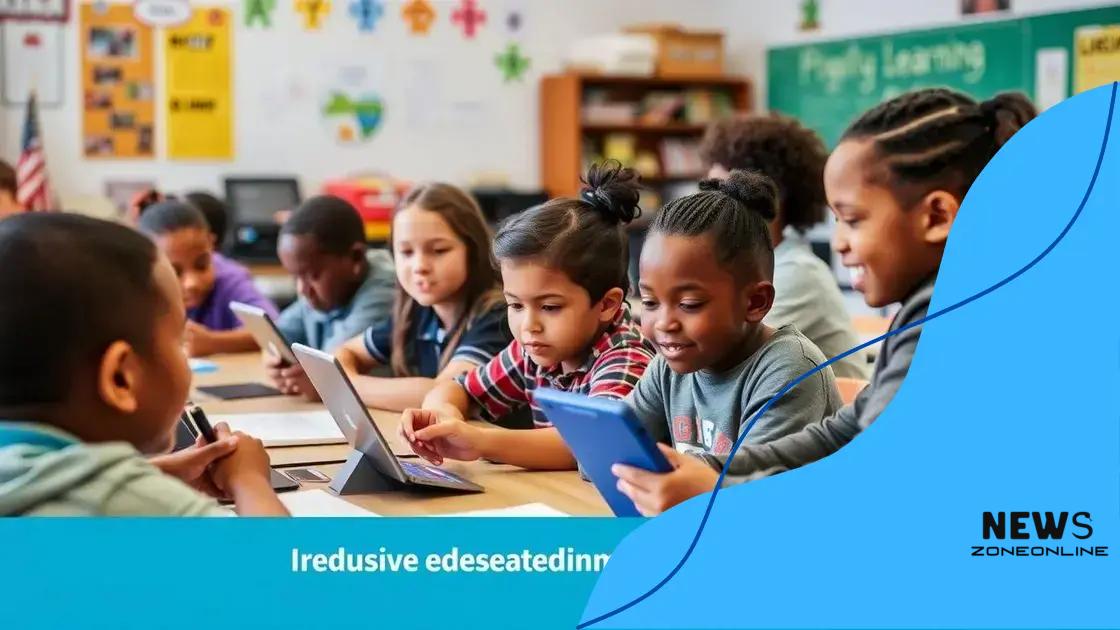Digital curriculum equity standards transforming education

Digital curriculum equity standards ensure that all students have equal access to educational resources and opportunities, promoting inclusive learning environments and addressing disparities in education.
Digital curriculum equity standards play a crucial role in shaping an inclusive educational landscape. But have you ever wondered how these standards influence learning outcomes for students from different backgrounds? Let’s dive into this important topic.
Understanding digital curriculum equity standards
Understanding digital curriculum equity standards is essential for ensuring all students have the resources they need to succeed. These standards provide a framework that helps educators create equitable learning environments, focusing on access and inclusion.
Importance of Digital Curriculum Equity
Digital curriculum equity addresses the diversity of learners in today’s classrooms. It is vital because:
- It ensures all students have equal access to digital resources.
- It supports varied learning styles and needs.
- It promotes collaboration among teachers and students.
By recognizing the importance of these standards, educators can enhance the learning experience for every student.
Key Components of Digital Curriculum Equity Standards
Digital curriculum equity standards comprise several key components that guide educators. These include curriculum accessibility, cultural relevance, and appropriate technology integration. Understanding each element is important:
- Accessibility: Curriculum materials should be easy to access for all students.
- Cultural relevance: Content must reflect the diverse backgrounds and experiences of students.
- Technology integration: Utilizing the right tools ensures effective learning.
Implementing these components helps establish an equitable educational environment.
Furthermore, training educators on these standards is critical. Professional development can equip teachers with the skills they need to embrace differentiation in their teaching methods. This means they can tailor instruction to meet individual needs, making learning more effective. As educators become more familiar with these standards, they can better adapt their teaching strategies to promote success.
Finally, ongoing assessment and feedback are crucial in maintaining equity. Regularly reviewing student progress helps identify gaps in learning. This process allows educators to adjust their approaches accordingly, ensuring that every student receives the support they need to thrive.
The importance of equitable access in education
The importance of equitable access in education cannot be overstated. When all students can access the same resources, they have a better chance to succeed. Equitable access ensures that every learner, regardless of their background, can participate fully in the educational experience.
Why Equitable Access Matters
Equitable access helps to break down barriers that some students face. This includes factors like socioeconomic status, geographic location, and disability. By addressing these barriers, educators can create a more inclusive environment. Here are some key reasons why equitable access is vital:
- Fosters inclusion: All students, regardless of their circumstances, feel valued in a fair learning environment.
- Enhances opportunities: Access to quality resources opens doors for students to achieve their goals.
- Builds community: An equitable education system brings together diverse groups, fostering mutual respect and understanding.
When schools provide equitable access, they promote fairness and social justice. It’s essential to recognize that not all students start from the same place. Some may face challenges that others do not. By ensuring all students have equal access to tools and resources, educators can help level the playing field.
Strategies for Promoting Equitable Access
There are various strategies that can promote equitable access in education. These include integrating technology effectively and providing targeted support to those in need. Schools can implement programs that focus on:
- Technology integration: Using digital tools to enhance learning and reach all students.
- Resource allocation: Ensuring that all classrooms have access to necessary materials.
- Training educators: Equipping teachers with skills to address diverse learning needs.
Such strategies can significantly impact students’ learning experiences, leading to improved educational outcomes. It’s about creating a system where every student has what they need to thrive. By prioritizing these efforts, we can help ensure that every child can reach their full potential.
Implementing digital curriculum for diverse learners

Implementing a digital curriculum for diverse learners is crucial in today’s educational landscape. It allows educators to meet the varying needs of all students. When teachers utilize this approach, they can create a tailored learning environment that supports everyone, including those with different backgrounds and abilities.
Strategies for Implementation
There are several strategies that can help in implementing a digital curriculum effectively. These include:
- Differentiation: Adapting lessons to meet the unique needs of each student.
- Use of technology: Incorporating tools that enhance learning experiences.
- Collaborative learning: Encouraging students to work together on projects to promote inclusivity.
These strategies ensure that every learner engages meaningfully with the curriculum. By focusing on differentiation, teachers allow students to progress at their own pace. Using technology effectively can also help facilitate various learning styles.
Creating Accessible Learning Materials
Another important aspect is the creation of accessible learning materials. This means providing resources that all students can use, regardless of their abilities. For example, materials should be available in multiple formats, such as text, audio, and video. By offering diverse options, students can choose what works best for them.
Additionally, it’s essential to implement regular feedback mechanisms. This helps educators understand how well students connect with the curriculum and allows for adjustments as needed. By gathering feedback, teachers can improve the learning experience continuously.
Professional development for educators is also crucial. Training sessions can help teachers learn effective ways to use digital tools and create inclusive curricula. By investing in teacher training, schools can enhance their overall effectiveness in implementing a digital curriculum for diverse learners.
Challenges in achieving curriculum equity
Challenges in achieving curriculum equity are significant and multifaceted. While the goal is to create an equal learning environment for all students, several hurdles make this a complex issue. Understanding these challenges is the first step in addressing them effectively.
Resource Disparities
One of the major obstacles is the disparity in resources among schools. Schools in wealthier areas often have access to better facilities, technology, and educational materials. In contrast, schools in underfunded areas struggle to provide even basic resources. This inequity leads to significant differences in educational quality.
- Funding inequalities: Public school funding often relies on local taxes, which creates variations between districts.
- Access to technology: Students in lower-income schools may lack necessary devices and internet access.
- Quality of materials: Higher-budget schools can afford updated and diverse curriculum materials.
These disparities make it more challenging for students in underfunded schools to compete on an equal level.
Socioeconomic Barriers
Another hurdle is the socioeconomic status of students. Factors such as family income, parental education levels, and support at home can significantly impact a student’s academic performance. Students facing economic hardships often encounter difficulties like:
- Limited study time: Many students take on jobs to support their families, reducing time for homework or study.
- Lack of support: Students may not receive adequate academic help at home.
- Emotional stress: Economic uncertainty can lead to trauma, affecting concentration and motivation.
Recognizing and addressing these challenges is essential to moving towards educational equity.
Policy and Implementation Issues
Finally, policy issues play a significant role in curriculum equity. Sometimes, even well-intended policies fail to reach the intended goals. Implementation can be uneven, and training for educators may be lacking. Additionally, standardized testing often does not account for the diverse backgrounds of students, further complicating the landscape of equitable education.
It is crucial for policymakers to evaluate their approaches continuously. Listening to educators and addressing the unique needs of different communities can help create more effective solutions. Overall, the journey toward curriculum equity is complex, filled with challenges that require ongoing attention and concerted efforts.
Future trends in digital education standards
Future trends in digital education standards are shaping how students learn and engage in the classroom. As technology evolves, so do teaching methods and educational frameworks. These trends aim to create more engaging, inclusive, and effective learning environments for all students.
Personalized Learning Experiences
One significant trend is the shift towards personalized learning. This approach tailors education to meet each student’s unique needs. By using data analytics and learning management systems, educators can:
- Monitor progress: Track individual student performance and adapt lessons accordingly.
- Offer tailored resources: Provide materials suited to different learning styles and paces.
- Enhance engagement: Use adaptive technologies to keep students motivated.
Personalized learning allows students to take ownership of their education. This trend emphasizes the value of each learner’s pathway and promotes a deeper understanding of the material.
Increased Use of Artificial Intelligence
Another trend is the increasing integration of artificial intelligence (AI) in education. AI tools can assist teachers in various ways, which includes:
- Automating assessments: Providing instant feedback on student work.
- Creating intelligent tutoring systems: Offering support to students outside of classroom hours.
- Analyzing learning patterns: Helping educators understand how students interact with material.
By incorporating AI, educational institutions can enhance instructional methods and learn from vast data sets to improve overall outcomes.
Focus on Social-Emotional Learning
Additionally, there is a growing emphasis on social-emotional learning (SEL). This trend recognizes that emotional intelligence is vital for student success. Schools are increasingly integrating SEL into their curriculums to:
- Build resilience: Teach students coping strategies for stress.
- Enhance collaboration: Foster teamwork and communication skills.
- Promote well-being: Support mental health and emotional growth.
By prioritizing SEL, educators can create a supportive environment that addresses the holistic needs of students.
As these trends in digital education standards continue to evolve, they present exciting opportunities for improving outcomes. Embracing innovation and adapting to the changing landscape of education is vital for future success.
FAQ – Frequently Asked Questions about Digital Curriculum Equity Standards
What are digital curriculum equity standards?
Digital curriculum equity standards are guidelines that ensure all students have equal access to educational resources and learning opportunities, regardless of their background.
Why is equitable access important in education?
Equitable access addresses disparities in education by providing all students with the resources they need to succeed, promoting fairness and improving educational outcomes.
How can technology support equitable curriculum implementation?
Technology can enhance curriculum delivery by offering diverse learning tools, facilitating personalized learning experiences, and ensuring resources are accessible to all students.
What role does social-emotional learning play in curriculum equity?
Social-emotional learning helps students develop emotional intelligence and resilience, which are crucial for their overall success and well-being in an equitable education system.





